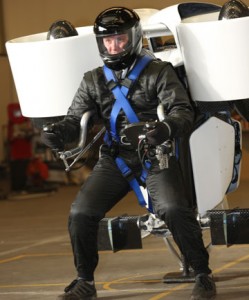The Air and Water Jetpack Has Arrived
One of the most widespread fantasies throughout all of humanity has been the ability to fly. Gravity consistently has shot those dreams down. Since at least the 1920′s, the Jetpack AKA the Rocketbelt, Jetbelt, and Rocketpack was thought to be the medium to finally defeat gravity. True Jetpack technology wasn’t even possible until the 1960′s, but those of us living in the 21st century may finally get to experience personal flight once and for all.
As with most technology, the first applications were military. In WWII, Germany experimented with the ‘Himmelsturmer’ AKA the Sky Stormer. Soliders were able to leap nearly 200 horizontal feet at a height of 50 feet to evade minefields and cross treacherous waters. The U.S. military around the same time tried a concept called the Bell Rocket Belt that was able to fly for 26 seconds on a full tank of gas. Both had their flaws and were pretty unremarkable.
Fast forward to the 21st century and a company called Martin Jetpack is trying to do the unthinkable: make a safe, sustainable Jetpack for commercial use. Since 1998, Martin has gone through eight separate prototypes before finally, in 2005, finding a model that could sustain flight for a useful amount of time. While still not available for sale, the Martin Jetpack is pretty close to being in your garage next to your jet ski and snowmobile. This year, an unmanned version of the pack made a climb to 5,000 feet in Britain.
The current model is still a bit bulkier than what science fiction gurus imagined, but it’s manageable at 5′ x 5.5′ x 5 and weighing 250 pounds. The Marin Jetpack is fueled by premium gas in a 4 cylinder, 200 hp, 2.0L engine. It can support individuals weighing between 140-240 pounds, and can climb at almost 1,000 feet per minute to an estimated height of 8,000 feet. Right now, the Jetpack can attain a cruising speed of 60 miles an hour for 30 mins.
Safety is obviously a major concern for those dangling above the Earth, but it is one that Martin has addressed. The Jetpack comes complete with a backup flight system in case the original goes out, an impact absorbing carriage, and a ballistic parachute system. Makes you breathe a little easier doesn’t it? Believe it or not, you wouldn’t need a pilot’s license; just a training course administered by Martin.
The obvious question is, how do we address potentially thousands of people jetpacking around the skies at once? The FAA is working on a 3D air traffic system to manage potential sky traffic using GPS technology. The FAA speculates that we might not be able to support humans jetpacking their commute for another 10 years.
The uses for the refined Jetpack are many, including military for quick and efficient transportation, recreation, and search and rescue. It’d be pretty awesome to strap on one and skip the ski lines, but that probably won’t be feasible until they can come out with a more compact model. Cost estimates are currently at $120,000, or a couple of pretty premium sports cars. The ability to fly at will is pretty difficult to pass up though.
If you’re afraid to risk your life with untested technology above solid ground but still want to experience the sensation of personal flight, have no fear, the water powered Jetpack is here. Two separate models are now available for purchase: one called the JetLev and another called the Flyboard. They both incorporate water propulsion systems docked to a floating motor in the water. With the Flyboard, you’re able to stand on a surface which emits water, as well as having two jets coming from your hands for support. The Jetlev is operated purely from your shoulders.
The founder of the Flyboard compares the sensation to snowboarding; unleashing a plethora of jaw-dropping stunts with the comfort of liquid water below. You can speed across the deep blue horizontally, or if you prefer, hang out 20 feet in the air. Things can get pretty wet and wild as flips, spins and dives are all possible.
With the JetLev, you can get up a little bit higher; up to 30 feet. Powered by a 200 HP engine, you can speed around both above and below the surface. The JetLev is capable of speeds up to 25 mph, with capacity for four hours of enjoyment on a tank. With this new future tech, you can literally walk on water. Daniel Tosh once said it was difficult to frown on a Jetski, and it may be impossible not to giggle on one of these.
What kind of future applications can you see the Jetpack having? What would you do to be able to test one out? How much would you pay? Here’s hoping they get to be mainstream sooner rather than later.
Comments
Tags: FlyBoard, Jetbelt, JetLev, JetPack, Martin Jetpack, Rocketbelt, Rocketpack
Trackback from your site.


Comments (3)
observer
| #
Well, this sounds like something that would be more of a recreational vehicle, there are just too many safety considerations, can you imagine the cost of insurance?
Reply
Lana
| #
This is freakin SWEEEEET
Reply
Lana
| #
This just in!
August 28, 2012
“Assembly of Prototype 12 started…
The engine for the new prototype has been assembled, while the pieces of the first duct and the airframe are now going together. The second duct, and other key components, are in manufacture and are due to be ready for assembly soon.
James, who is our current remote control pilot, is over half way through his microlight training in preparation for being one of the two test pilots for manned test flying of P12 later this year.
We are also having the earthquake damage to our building repaired at the moment, which is causing some disruption, but has been a good excuse to do a bit of ‘spring cleaning’ as well.
http://martinjetpack.com/blog.aspx
Reply